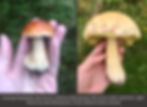King Boletes / Wild Porcini Mushrooms
- katemacquarrie22
- Aug 30, 2023
- 3 min read
Updated: Aug 6, 2024
One of my favourite things about PEI’s wild foods is how they sometimes appear when you least expect it. On two different outings recently, I wasn’t looking for fungi but found King Boletes (aka Porcini, Boletus edulis group), including some on my own property! These are expensive, gourmet mushrooms that are hard to find in stores, but commonly found growing wild on the Island.

Like many wild foods, bigger isn’t necessarily better with mushrooms. Older specimens are more likely to be damaged by slugs or insects, and sometimes have a less pleasant texture. With Porcini, smaller ones are considered choice (Photo 1, left), but I don’t pass up larger ones if they are firm and free from insect damage (Photo 1, right).

Unlike the commercial mushrooms you may be familiar with, Boletes have spongy pores rather than gills under the cap. King Boletes are fairly easy to identify by their fat stipes (stems) with reticulation – that raised, white net-like pattern you can see at the top of the stipe in Photo 2. When you cut into a King Bolete, you’ll find the flesh is white while the pores may be white, yellowish, or greenish. Unlike some Boletes, Kings don’t change colour when you cut them. The caps of these mushrooms often look a lot like bread (Photo 3), giving them another common name: ‘Penny Bun’.

You can find a ton of recipes for using fresh King Bolete / Porcini mushrooms, but I usually start with just pan-frying in butter to let their flavour shine (Photo 4, left). The white flesh is dense and meaty, while the pores have a softer texture that some people don’t like. You can remove the pore layer before cooking, but I usually leave it on unless the mushroom is quite old, or there’s sign of insect damage. Don’t throw the stipe away! Its flavour is every bit as good as the cap. King Boletes also dry and rehydrate well.
This is a rich, flavourful mushroom that not only stands up well on its own but also makes a great addition to pizza, pasta, sauces, soups, or anywhere else you’d like that ‘umami’ flavour. One of my favourites is simply scrambled eggs with King Boletes and smoked gouda (Photo 4, right). You can find my recipe for this in the Wild Food Recipes section of this blog.

King Boletes grow directly from the ground, often under or near spruce trees. I’ve found them in old fields, along trails, and even on lawns in Charlottetown! Like all mushrooms, the above-ground part you see is just the fruiting body – like an apple on a tree. The fungus itself exists as a network of mycelium in the soil. Picking a mushroom is like picking an apple: it doesn’t matter whether you pull it up or cut it from the ground with a knife. When mushroom hunting I’ll often use a knife to keep my harvest cleaner, but I wasn’t expecting to find these and – with no knife on hand – just plucked them.
King Boletes / Porcini are among PEI’s easily identified choice edibles, and you don’t need to be an expert to identify them (I’m not!). Our recent wet weather has encouraged mushrooms to pop up all over the place, and there’s also tons of Chantrelles, Puffballs, and Shaggy Manes around right now. It’s the perfect time of year to enjoy this delicious part of PEI untamed!
